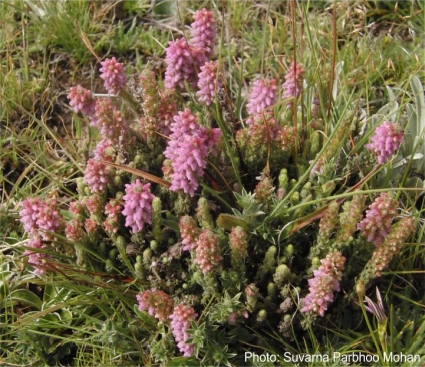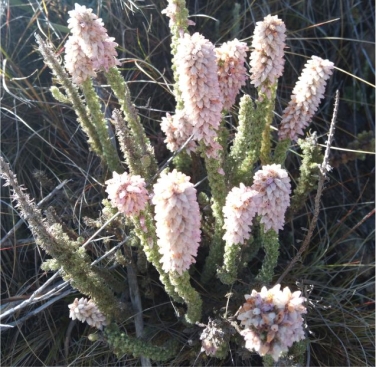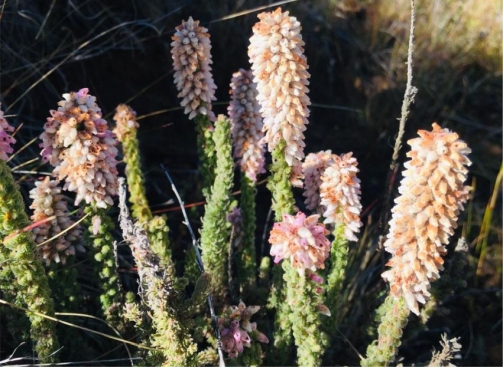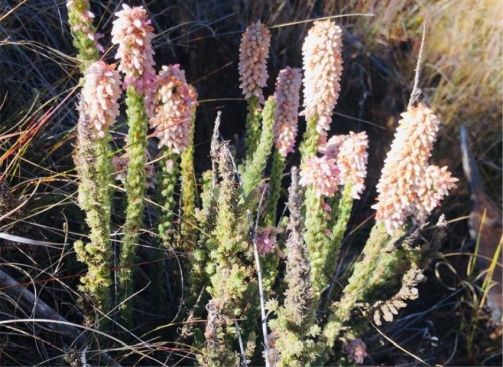Erica alopecurus
Erica alopecurus Harv.
Family: Ericaceae
Common names: foxtail heath (Eng.); katstertheide (Eng.); chalbeke-e-nyenyane, chesa-litelu, molomo-oa-lekolo-kotoane (Sesotho)
Introduction
Foxtail heath has interesting, leafy branches that resembles a fox’s tail, as the common name suggests. It has densely clustered spikes of small, inflated, pink flowers, which attract attention from a distance.

Description
Description
Erica alopecurus is a low, rounded, clustered and erect shrub, which grows up to 350 mm tall. Leaves are in threes, linear, obtuse, 4–5 mm long, hairy, curving towards the inside, with the midrib visible beneath. Flowers are 3 mm long, hairy, pink, urn-shaped, crowded in cylindrical spike-like inflorescences toward the tips of branches, from late summer to spring (March to October). The flowers turn brown after flowering.

One variety is recognised: Erica alopecurus var. glabriflora, which has a hairless corolla; specimens with hairy and hairless corollas are found in the same areas.
Conservation Status
Status
Erica alopecurus is currently listed as Least Concern (LC) on the Red List. Even though this plant is not threatened, conservation measures have been taken as insurance, should anything happen to the current populations of Erica alopecurus. The MSBP (Millennium Seed Bank Partnership) has safely banked the seeds of this species as back-up for future restorations and reintroductions.

Distribution and habitat
Distribution description
Erica alopecurus is endemic to southern Africa, occurring in South Africa and Lesotho. It is widespread in South Africa, occurring in Eastern Cape, KwaZulu-Natal, Free State, Gauteng, Mpumalanga and North West. It is found growing on rocky, mountainous terrain near streams and in kloofs.

Derivation of name and historical aspects
History
The name of the genus Erica was derived from a Greek word ereiko which means to tear something into pieces. This name came about because ancient Greeks believed that some heaths species had the ability to break down gallstones. The species name alopecurus comes from alopex which is a Greek name for fox, and oura, meaning tail; it refers to the upright, densely leafy branches that resemble a fox’s tail and this leads to the English common name, foxtail heath.
The genus Erica has approximately 840 species that are found mainly in Africa and Europe, of which 806 occur in South Africa, mainly in the Western Cape. Erica alopecurus is one of the few species that occur in the summer-rainfall region of South Africa.

Ecology
Ecology
Erica alopecurus is pollinated by small insects. When the fruit turns brown and dry, it splits and releases tiny, light seeds, which are easily dispersed by wind.
Uses
Use
Foxtail heath is known to be used by people for burning as fuel. It is also a good garden display plant that can be used ornamentally.

Growing Erica alopecurus
Grow
Not much is said about growing Erica alopecurus but like most species of Erica they grow best in well-drained soils, and if grown in heavy soils, rocks and stones should be added below the soil to improve drainage. They should be grown in full sun with good air circulation. Ericas need acidic soils with a pH balance between 4 to 6.5. They are grown from seeds and from cuttings which are stimulated with rooting hormone. Once planted, do not uproot or disturb the roots. For better germination, Erica seeds are treated with smoke .
References
- Baker, H.A. & Oliver, E.G.H. 1967. Ericas in southern Africa. Purnell & Sons, Cape Town.
- Foden, W. & Potter, L. 2005. Erica alopecurus Harv. var. alopecurus. National Assessment: Red List of South African Plants version 2020.1. Accessed on 2022/08/29
- Guthrie, F. & Bolus, H. 1905. Ericaceae. Flora capensis 4(1).
- Kamundi, D.A. & Victor, J.E. 2006. Erica alopecurus Harv. var. glabriflora Bolus. National Assessment: Red List of South African Plants version 2020.1. Accessed on 2022/09/07
- Manning, J. & Batten, A. & Bokelmann, H. 2001. Eastern Cape South African Wild Flower Guide 11. Botanical Society of South Africa, Cape Town
- New POSA, Plants of southern Africa online. Ericaceae and Erica search. http://posa.sanbi.org/sanbi/Explore. Accessed 7 Sep. 22.
- Parbhoo Mohan, S. 2012. Observation of Erica alopecurus, Sani Pass. iNaturalist, Online. https://www.inaturalist.org/observations/10986561.
- Plants of the World Online. Erica Tourn. Ex L. https://powo.science.kew.org/taxon/urn:lsid:ipni.org:names:30249382-2. Accessed 7 Sep. 22.
- Pooley, E. 2005. A field guide to wild flowers KwaZulu-Natal and the eastern region. The Flora Publications Trust, Durban.
- Schumann, D., Kirsten, G. & Oliver, E.G.H. 1992. Ericas of South Africa. Fernwood Press, Vlaeberg.
- Williams, N. & Notten, A. 2008. Erica hirtiflora Curtis. (Ericaceae). PlantZAfrica. Online. http://pza.sanbi.org/erica-hirtiflora.
Credits
Sibahle Gumede
Millennium Seed Bank Partnership
Kwelera National Botanical Garden
September 2022
Acknowledgements: the author thanks Suvarna Parbhoo Mohan for the images of Erica alopecurus in fresh flower, from her observation on iNaturalist, all other images by the author.
Plant Attributes:
Plant Type: Shrub
SA Distribution: Eastern Cape, Free State, KwaZulu-Natal, Mpumalanga, North West
Soil type: Sandy
Flowering season: Spring, Autumn, Winter
PH: Acid
Flower colour: Pink
Aspect: Full Sun
Gardening skill: Average
Special Features:
Horticultural zones









Rate this article
Article well written and informative
Rate this plant
Is this an interesting plant?
Login to add your Comment
Back to topNot registered yet? Click here to register.